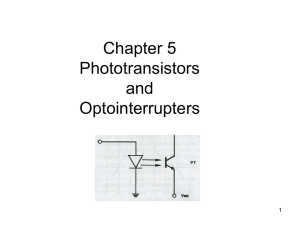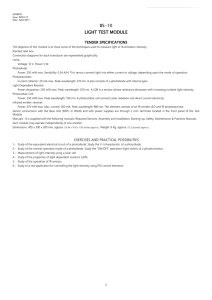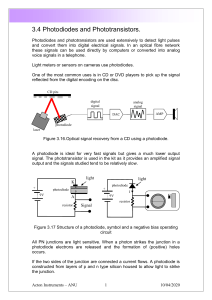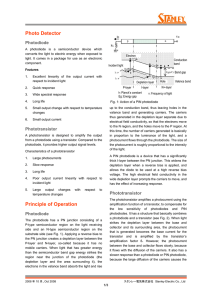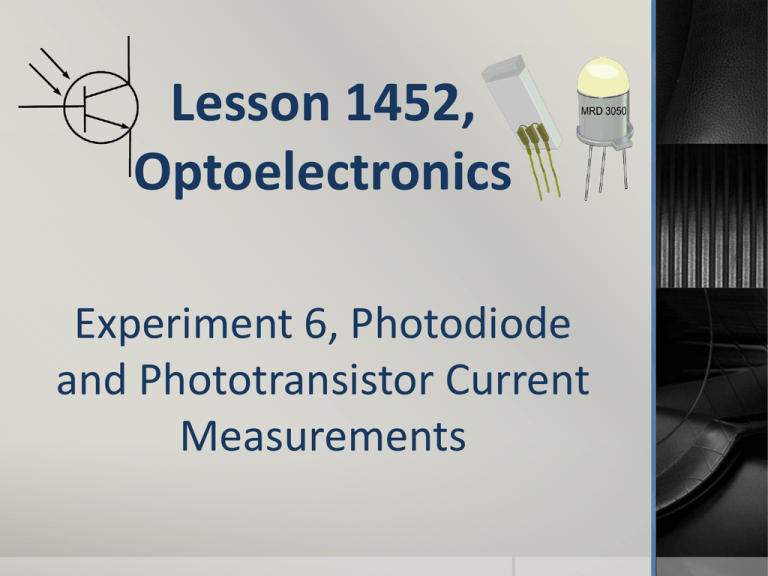
Lesson 1452,
Optoelectronics
Experiment 6, Photodiode
and Phototransistor Current
Measurements
Objectives
1) To show that current through a
photodiode increases as the light falling
on the device increases.
2) To verify that current through a
phototransistor varies with varying light
Introduction
We have seen in a previous experiment
that the resistance of both a photodiode
and a phototransistor changes as the
intensity of the light hitting the device
varies.
Today we will continue studying these
important devices by measuring the
current characteristics under various light
conditions
The diagram on the next slide shows a
properly biased photodiode.
Note: The polarity of the voltage source is
such that the photodiode is reversed biased.
Properly Biased Photodiode
Properly Biased Phototransistor
A similar situation exists in the circuit on
the next slide, which shows a properly
biased phototransistor
Note the base and collector are still
reverse-biased with this arrangement
The collector-base junction is reversebiased as well
Properly Biased Phototransistor
The photodiode resistance will change as
the light changes, causing the base
current to change as well
This changing current will be amplified by
the transistor, resulting in a change in
collector current
The current gain of the transistor is the
reason the current carrying capability of
the phototransistor in generally much
larger than that of the photodiode alone
Procedure
In this experiment, you will be using the
same phototransistor you used in the last
experiment
Photodiode measurements will be made
between the base and collector terminals of
the device
Phototransistor measurements will be
made between the collector and emitter
terminals of the device
We will be using a small lamp as a light
source.
The lamp will be set at a fixed distance from
the transistor
By varying the lamp voltage, we can change its
brightness and observe how the photodiode
and phototransistor currents vary
1. Before constructing the circuit, turn the
power supply on and set the positive
supply to + 15V and set the negative
supply to – 6V. Be careful not to change
these settings throughout the experiment!
2. Mount the phototransistor on the
breadboard as shown on the slide after
next
a)
Carefully bend the leads at a 90° so the
device points horizontally
3. Mount the lamp on the breadboard about
1 inch from the transistor
a)
Depending on the type of lamp supplied,
you may have to solder leads onto the lamp
or socket before mounting it to the
breadboard
4. With the power off, construct the circuit
shown on the following slide
a)
The base lead is to be connected to ground
b) The collector lead is to be connected to R2
c) Note: The emitter lead is left unconnected
Photodiode Measurement Ckt
5. Switch your meter to the 50mA range
and connect it in series as shown on the
schematic and in the pictorial.
6. Turn on the power and set R1 so that the
lamp is off.
a) Measure the current through the
photodiode and record the voltage in the
table on the following slide
Data Table for Experiment 6
7. Using your volt meter, set voltage on the
meter across the lamp to 1 V
a) Replace meter with a jumper
b) Set meter to the 10 VDC range to measure
the voltage across the lamp
8. Return the meter to measure the current
again and place the value in the data table
9. Continue with each of the lamp voltages
in the table and measure & record the
current for each in the data table
10. Turn off the power and modify the circuit
using the following schematic to guide you
Phototransistor Measurement Ckt
11. Turn on the power and repeat all the
measurements for the various lamp
voltages in the data table and set your
meter to the 2.5 mA range
a)
Mark the results in the table
12. Our results can be seen on the following
slides
Results
Your results should be similar to ours, but
don’t worry if there are some
discrepancies.
Variations in lamp output, distance, and
photodiode and phototransistor
characteristics can all contribute to
experimental error
Data table with CIE Results
However; you should see the same general
trend.
As the lamp intensity increased, the current
should have increased as well, because of the
decreased resistance
The phototransistor current should have
been much greater than the photodiode
current.
This is because of the current gain of the
transistor
Final Discussion
You measured both the photodiode and
the phototransistor characteristics.
With each of these devices, the current
increased as the light increased
The photodiode was measured by using
the base and collector leads of the
phototransistor
The phototransistor measurements were
made between the emitter and collector
leads of the this transistor
This is the normal operating mode for a
phototransistor, although you’ll often see
additional base bias applied through an
external resistor
To make the results repeatable, we used a
standard lamp to provide the light for the
phototransistors.
However, because of component tolerances
or differences, a wide range of variations from
device to device is to be expected
Your results probably were not linear, in that
the current did not increase as much as the
lamp voltage did.
Not only is the phototransistor itself less than
perfect, but the intensity of the lamp
probably didn’t increase linearly with changes
in lamp voltage either; all of which would
affect the results.
Phototransistors are often used as discrete
devices, but they will be found combined
with other components in some
applications.
Questions?
Resources
Rosenow. (2001). Lesson 1452:
Optoelectronics. Cleveland: Cleveland
Institute of Electronics.
The End
Developed and Produced by the Instructors
in the CIE Instruction Department.
© Copyright 06/2012
All Rights Reserved / June 2012

